Journal of
eISSN: 2378-3184


Research Article Volume 4 Issue 4
Center of Excellence in Marine Biology, University of Karachi, Pakistan
Correspondence: Sher Khan Panhwar, Center of Excellence in Marine Biology, University of Karachi, Pakistan, Tel 92 21 9926 1551
Received: September 08, 2016 | Published: October 7, 2016
Citation: Fatima A, Panhwar SK, Shaikh W, Mairaj M, Farooq N, et al. (2016) Preliminary Observations on Elasmobranchs Captured in Pakistan. J Aquac Mar Biol 4(4): 00092. DOI: 10.15406/jamb.2016.04.00092
Little is known about elasmobranches in Pakistan despite their enormous diversity, commercial value and export earning adding into nation’s economy. In this study, preliminary data was gathered and document some observations on elasmobranches and their current state. Some regular observations have been made between 2015-2016 at monthly intervals for two key landing centers, the Karachi Harbour and Ibrahim Hyderi Fish Center. Specimens of small elasmobranches transported to the laboratory, whereas, larger specimens of more than 100cm TL were identified and measured at the Harbour. It was noted that family Carcharhinidae (grey sharks) locally called as “mangra” found in substantial amounts during winter and consistently landed throughout the year. Family Dasyatidae (batoid fishes) known as “pitten” in local dialect was in sufficient amount during summer whereas lower catches appeared in winter. Among guitar fishes Family Rhinobatidae most abundant family was found in the winter catches and the lowest in summer months. This study was aimed to evaluate potential of common elasmo branch species and gather data on abundance, seasonal variation and morphometry. It is expected that this baseline data would help biologists and conservatives for further investigation on elasmobranches in the area.
Keywords: Elasmobranchs, Species potential, Seasonal variation, Pakistan
Current advanced fishing techniques to capture elasmobranches and irresponsible fishing practices has led to their massive decline around world (Annexes to CITES, 2nd revised version). These top predator fishes are slow growing, late maturing, long-lived and low fecund rate made them vulnerable to over harvesting.1 Approximately 1000 species of sharks and rays have been reported2 whereas 144 shark species have been reported but no separate data of skates are available in Pakistan. Approximately 100 species of sharks have been exploited commercially and among them around 20 species become vulnerable, endangered or critically endangered for instance silky shark, basking shark, porbeagle, narrow nose smooth-hound, pike dogfish, dusky shark and short fin mako shark.1 The countries involved in hunting of these sharks are Indonesia, India, USA, Pakistan, Mexico, Taiwan, Japan, Argentina, Srilanka, Brazil, Malaysia, France, UK, Korea, Thailand, Spain, New Zealand, Maldives and China.3 Every part of elasmobranchs is used for commercial purposes; the skin is used in leather products, liver is rich in vitamin-A, squalene is used as lubricant for tanning and curing of leather, its blood and cartilage is used for medical purposes and has been known to inhibit tumor growth, while extracted Chondroiten from cartilage is used as skin replacement for burn victims and also used in eye drops.4,5 In addition to this, shark cartilage is used for arthritic maladies in pets and sold as a food supplement for cats and dogs.3 Information on the species diversity, trade data, exploitation, mortality and use of the body parts of elasmobranchs are still unknown in Pakistan. This study provides baseline information about elasmobranches and could help in further studies on important fishery resource conservation and management in future.
Different fish landing centers in Karachi visited, where shark landing is concentrated at mainly 2 locations: Karachi fish Harbour (West wharf) and Korangi fish jetty. The small size samples collected from these sites and frozen for later laboratory analysis. In the case of larger size specimens, their TL (Total length), body weight (BW) and sex (M/F) were measured on the landing site. Monthly distribution and abundance of elasmo branch species are mentioned in some detail where as those of others are mentioned very briefly.
Data collection
Specimens were collected in various months from August 2015 to May 2016. All species were identified following the standard methods and identification keys. The identification of sharks was mainly based on their visible morphological characteristics and upper or lower teeth that are observed under binocular microscope while batoid fishes identified by their body profile and spiny tail. Every species occurring in the study area were recorded and later identified by photographic evidence but pictures from all specimens could not be taken due to unethical behavior of some fishermen. Data also gathered from local fishermen that work in the “Mangra slaughter factory” at Karachi Fish Harbour.
Morphometric analysis for sharks
The morphometric measurements of each shark were taken, in cm and included: Total length (TL), Fork length (FL), standard length (SL), Dorsal origin to pre-caudal pit (DOPCP), dorsal origin to caudal tip (DOCT), Inter-dorsal space (IDS), Head length (HL), Snout length (SL), Mouth Width (MW), Inter-nasal space(INS), observe labial furrow, body weight(BW) in gm/kg and sex (M/F). The sex determination was made on the on the visual examination of presence or absence of claspers in each individual. . In the larger size specimens only parameters such us TL, SL, Sex and weight were measured.
Morphometric analysis for Batoid fishes (Rays, guitar fishes and torpedo)
In rays the morphometric measurements, in cm, included: Disc length (DL), Disc width (DW), sex (M/F), presence of spines on their tail, tail length (either large or small by their disc length) whereas Total length (TL), body weight (BW) Sex (M/F) were measured in guitar fishes and torpedo. (Total length of some rays could not be measured because fishermen cut their tail and discard it due to the dangerous spine).
Elasmobranches often are caught as by catch in various fishing gears such as gillnets and trawls at depths of up to 300m. Before participation in 1940 about 16,000-17,000t were caught, after thirty years later catch statistics was 32,000t and reduced as 6,000t in 2009 but now around 5,000t (Figure 1). In addition to this, Pakistan is facing serious threats of overharvesting its marine resources and reached at 81% in the past 15 years (The Express Tribune; Dawn, 9/2014). FAO records mention that Pakistan have potential of 5% world stocks of elasmobranchs includes Batoids and grey sharks Carcharhinidae and the total world landing of sharks from around 272,000t in 1950 to 760,000t in 1996.6 By catch statistics of the elasmobranches fisheries includes sharks and rays was estimated at the end of 1980 at 260,000t between 300,000t or 11.6-12.7m fish mainly blue sharks and it was increased in 1990 above 50,000t by pelagic gillnet vessels working in Somalia, Yemen and Oman and Pakistan coastal water.7 Capture production also includes some pregnant female sharks caught during breeding season comprises of hammerhead shark, grey bamboo shark, black tip shark, pelagic thresher shark and spade-nose shark Animal rights in Pakistan.8 Behzadi9 reported Dasyatidae, Gymnuridae, Myliobatidae and Dasyatidae are the key families of elasmobranchs in Oman Sea and Persian Gulf. In Pakistan tiger shark, hammerhead shark, mako shark, bull shark, silky shark, reef shark, hound shark, graceful shark and spinner shark have been commonly occurring species, whereas since 1985 only three specimens of the saw shark have been reported in Pakistan but now saw sharks are almost disappeared. In this study we have recorded monthly distribution and abundance of elasmobranchii species in the month of Aug-Nov 2015 to March-May 2016 with sex differences (M/F) at major fish landing site Karachi fish harbor (West wharf).
However, elasmobranchii were categorized into 13 families and their 27 species in which 10 sharks species consist of 5 families (Figure 2) and the most abundant family is Carcharhinidae while 10 ray species consist of 5 families and the most abundant family is Dasyatidae and 4 species of guitar fishes consist of one family Rhinobatidae remaining 3 torpedo species in which one is un described consist of two Narcinidae and Torpedinidae. The most commonly caught shark species were recorded milk shark (Rizoprionodon acutus) of the family Carcharhinidae, whereas spade nose shark (Scoliodon laticaudus) remained in the catches throughout the year (Figure 3) and abundantly found in August, September, October and November (Table 1) . In ray species (Figure 4) commonly caught specie is Himantura bleekeri (Bigeye thresher) belonging to family Dasyatidae mostly found in summer catch March, April and May and in guitar fishes Glaucostegus halavi (Halavi ray) belonging to family Rhinobatidae (Figure 5) abundantly seen in the month of April and May (Table 1). We also observe male or female catch rate at harbor during study period in which shark species have high female catch rate as compared to male (Figure 6), ray species have high female sex rate but long tail butterfly ray (Gymnura poecilura) were male it is the rare species of rays at harbor and can be seen hardly (Figure 7) while guitar fishes have high male sex rate as compared to female (Figure 8). Among elasmobranches saw fishes and chimaeras were totally disappeared during this period.
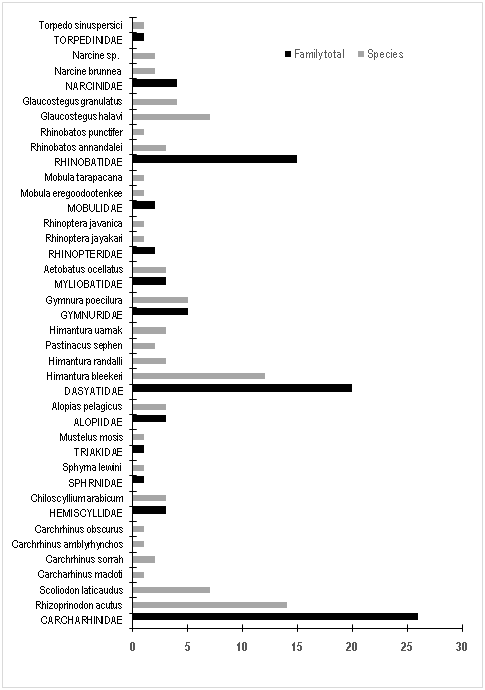
Figure 2 Composition of twenty seven species of thirteen Elasmobranch families found abundantly in Pakistan during 2015-2016.

Figure 3 Most abundant catch species of Rhizoprionodon acutus sharks and Scoliodon laticaudus, belonging to the family Carcharhinidaefound in the Karachi Fish harbor.
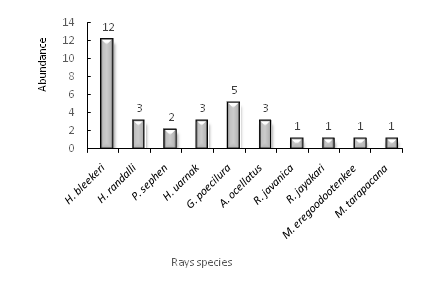
Figure 4 Most abundant ray Himantura bleekeriof the family Dasyatidaefound at the Karachi Fish harbor.
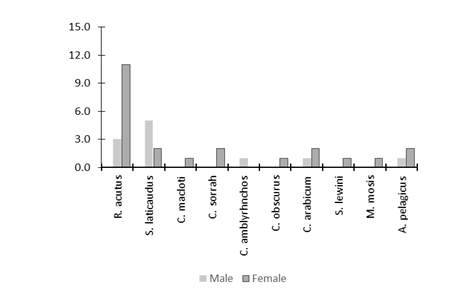
Figure 5 Recorded male and female catch ratio of shark species in which mostly females were found in the Karachi fish harbor.
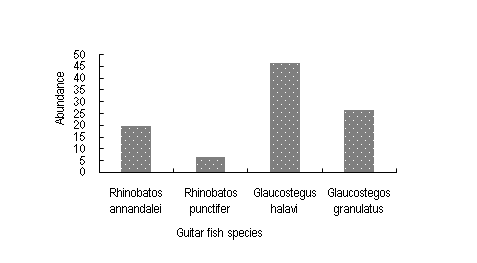
Figure 6 Abundant species of guitar fishes that are found in the Karachi Fish market. The most abundant species is Glaucostegus halavi(Halavi ray) belonging to the family Rhinobatidae.
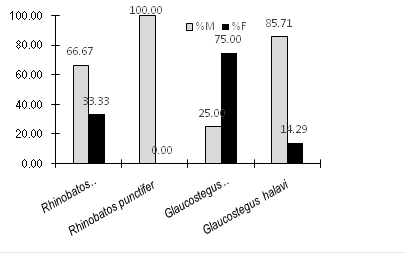
Figure 8 Recorded male and female catch ratio of Guitar fishes belong to the family Rhinobatidae recorded at the Karachi fish harbor.
|
Species (Sharks and Batoid Fishes) |
Common Name |
Aug 2015 |
Sept 2015 |
Oct 2015 |
Nov 2015 |
March 2016 |
April 2016 |
May 2016 |
|
Carcharhinidae |
|
|||||||
|
Rhizoprinodon acutus |
Milk shark |
X |
X |
X |
X |
X |
X |
X |
|
Scoliodon laticaudus |
Spade nose shark |
X |
X |
X |
X |
X |
X |
X |
|
Carcharhinus macloti |
Hard nose shark |
X |
||||||
|
Carchrhinus sorrah |
Spot tail shark |
X |
X |
|||||
|
Carcharhinus amblyrhnchos |
Black tail reef shark |
X |
||||||
|
Carcharhinus obscurus |
Dusky shark |
X |
||||||
|
Hemiscyllidae |
|
|
|
|
|
|
|
|
|
Chiloscyllium arabicum |
Arabian carpet shark |
X |
X |
X |
||||
|
Sphyrnidae |
|
|
|
|
|
|
|
|
|
Sphyrna lewini |
Scalloped hammerhead shark |
X |
||||||
|
Triakidae |
|
|
|
|
|
|
|
|
|
Mustelus mosis |
Arabian smooth hound |
X |
||||||
|
Alopiidae |
|
|
|
|
|
|
|
|
|
Alopias pelagicus |
Pelagic thresher |
X |
||||||
|
Dasyatidae |
|
|
|
|
|
|
|
|
|
Himantura bleekeri |
Big eye thresher |
X |
X |
X |
X |
X |
||
|
Himantura randalli |
Arabian banded whip ray |
X |
X |
X |
||||
|
Pastinacus sephen |
Cow tail stingray |
X |
||||||
|
Himantura uarnak |
Reticulate whip ray |
X |
X |
|||||
|
Gymnuridae |
|
|
|
|
|
|
|
|
|
Gymnura poecilura |
Long tail butterfly ray |
X |
X |
|||||
|
Myliobatidae |
|
|
|
|
|
|
|
|
|
Aetobatus ocellatus |
Ocellated eagle ray |
X |
X |
X |
||||
|
Rhinopteridae |
|
|
|
|
|
|
|
|
|
Rhinoptera jayakari |
Oman cownose ray |
X |
||||||
|
Rhinoptera javanica |
Javanese cow nose ray |
X |
||||||
|
Mobulidae |
|
|
|
|
|
|
|
|
|
Mobula eregoodootenkee |
Long horned mobula |
X |
||||||
|
Mobula tarapacana |
Sickle fine devil ray |
X |
||||||
|
Rhinobatidae |
|
|
|
|
|
|
|
|
|
Rhinobatos annandalei |
Annandale’s guitar fish |
X |
X |
|||||
|
Rhinobatos punctifer |
Spotted guitarfish |
X |
||||||
|
Glaucostegus granulatus |
Granuled guitarfish |
X |
X |
|||||
|
Glaucostegus halavi |
Halavi guitarfish |
X |
X |
X |
||||
|
Narcinidae |
|
|
|
|
|
|
|
|
|
Narcine brunnea |
Brown numb fish |
X |
||||||
|
Narcine sp. (undescribed) |
|
X |
||||||
|
Torpedinidae |
|
|
|
|
|
|
|
|
|
Torpedo sinuspersici |
Variable torpe ray |
X |
Table 1 Monthly record of occurrence of various elasmobranchs recorded during 2015-2016 at two key fish landing sites
Limited research has been conducted on elasmobranches in Pakistan. The population of these fishes is drastically declined. There is a need to gather species wise catch statistics and trade records must be maintained. There is urgent need to study population biology, ecology and impact of changing marine environment in the areas where elasmobranches population seems at high risks.
Some implication for elasmobranch conservation
None.
None.

©2016 Fatima, et al. This is an open access article distributed under the terms of the, which permits unrestricted use, distribution, and build upon your work non-commercially.